|
FAQs about Seahares,
Suborder Anaspidea,
Identification
Related Articles: Sea Slugs, Nudibranchs,
Related FAQs: Seahares
1, Seahare Behavior, Seahare Compatibility, Seahare Stocking/Selection, Seahare Systems, Seahare Feeding, Seahare Disease, Seahare Reproduction, & FAQs on:
Seaslugs 1, Seaslugs 2, Seaslug Identification, Seaslug Behavior, Seaslug Compatibility, Seaslug Selection, Seaslug Systems, Seaslug Feeding, Seaslug Disease, Seaslug Reproduction, & Marine Snails 1, Marine Snails 2, Marine Snails 3, Nudibranchs, Nudibranchs 2, Nudibranch Identification, Nudibranch Behavior, Nudibranch Compatibility, Nudibranch Selection, Nudibranch Systems, Nudibranch Feeding, Nudibranch Disease, Nudibranch Reproduction, Berghia Nudibranchs, Snail ID 1, Snail
ID 2, Snail ID 3,
|
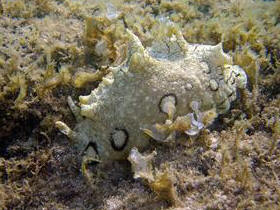
|
|
Sea slug identification
6/26/15
Hello,
I found a small sea slug last night that resemble a sea hare but haven't been
able to ID it. I looked through your sea slug identification pages and it sort
of resembles the sea slug on page 3 identified as a blue ring sea hare but I
don't see any rings on it and it looks a little more reddish brown. I have
attached some photos. Thanks in advance for you time.
Craig
<Mmm; no pix attached. Please try sending again. Bob Fenner>
Re: Sea slug identification
6/26/15
Oops sorry I forgot to attach them, here they are, it's about 1"- 1 1/2"
for reference.
Thanks,
Craig
<Yes; this may be a young Bursatella leachii. B>
|

 |
|
Need ID
3/10/15
Hi Bob,
Someone reported that these washed up on a beach in Florida. They claim that
they could see a heartbeat. It looks like it has a siphon to me. A type of
Cephalopod? Which ones? I can't figure it out. What say you? Thank you.
Best,
Jan
<Mmm; nothing attached Jan... BobF>
Re: Need ID
3/11/15
ok. Will send via fb pm
<Appear to be Seahares. B> |
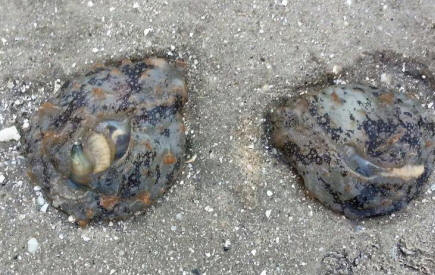 |
|
Re: Need ID
3/11/15
Thank you!!
<Ah; welcome. Have seen similar... Aplysia californica; off the coast at minus
tides several times. B> |
|
What is it 2/18/15
Hi Bob,
<James>
Have any idea what this is? In my son in law's tank. First thought was a
Cuke but never saw one on glass. Never saw one with "horns" either.
<Mmm, appears to be a Seahare; Anaspidean/Aplysiacea n.
Can be trouble if they "ink" in a small volume. BobF>
Thanks,
James |
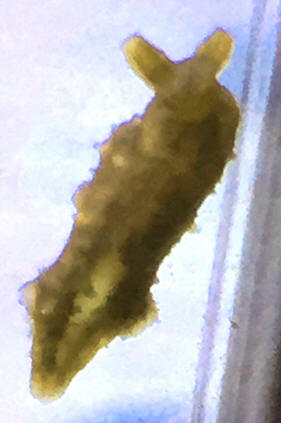 |
|
ID please 11/27/13
Hi guys,
<Hey Jo, where you goin' w/ that Aplysiid in your tank...?>
I wonder if you can help. A few months ago I found this little slug
which looked a bit like a Stomatella without a shell. It was only about
1cm long and as I wasn’t sure what it was, I took it out of my DT and
popped it in my QT (no medication present). He has now tripled in size
and starting to look a bit like a sea hare. He definitely has
the two sets of ‘horns’ just like a sea hare but is a bit more
flat. I think he is still growing but could you please have a look at
the photo attached? Seems to be feeding on micro algae in my QT but I
don’t want to risk putting it back in the DT as not sure what it is.
The family have become quite attached to it and my son even gave it a
name...
Many thanks and looking forward to your reply.
Jo
<I do think this is a Seahare as well... Perhaps Aplysia brasilinia, or
a Dolabella. Bob Fenner>
|
.jpg)
.jpg) |
Re: ID please
11/27/13
Wow, Bob, this was a fast reply, thanks!
Ok, Googled both suggested IDs and it looks like it might be the second -
Dolabella.
<Not uncommon... is some, your live rock from the tropical west Atlantic?>
Will do a bit more reading on its diet, etc, now I know it sort of creature
it is. A bit worrying that one site quotes max size 400mm though! I hope
not.
<That's in the wild... the general "rule of thumb" is about half for captive
specimens... Still dangerous/ly large... See WWM re... I really wish the
trade wouldn't sell Aplysiids... there ARE some quite small tropical
species; but the ones sold don't include these>
I think I will keep him in the QT for now and watch him grow, he is quite
fascinating and likes dried algae sheets.
Thanks for your help once again
Jo
<Welcome in turn. BobF>
Re: ID please 11/28/13
I just don't know where he came from as all my live rock in this tank (set
up in May) came from my old tank which has been set up since 2007!
<Mmm, well; likely something more recently put in with hard substrate>
The only thing I've added was a RBTA but again, that came on a small
branching rock
<Ahh; this is likely it>
and had been in a fellow reefer's tank for about 6 months (and I think it
was a tank split one). The slug was only tiny when I first found him.
Actually, I have also added a few bits of branching Tonga rock? I wonder if
I will end up taking it to a Marine Life Centre near us (we are in the UK)..
Off to do some more research on it
Thanks
Jo
<Do keep us informed; cheers. B> Re: ID please;
Seahare f'
1/13/14
Hey Bob,
<Jo>
I did a bit more research on this and it's Dolabrifera dolabrifera -
like the ones pictured here:
http://en.wikipedia.org/wiki/Dolabrifera_dolabrifera
and here:
http://www.seaslugforum.net/find/7971.
<Ahh, a Seahare as originally guessed; an even more common species>
From what I've read he will be feeding on various algae and even
Cyano
bacteria which is starting to show its ugly face in my tank again. As he
doesn't seem to present danger to my corals, I think I will move him
over to the display tank soon
Thanks again for helping me ID the little guy
Jo
<Thank you for this follow-up. BobF>
|
|
Pondering Mollusks
4/23/13
Dear Crew,
Good Afternoon!
I have three pictures of an interesting maybe
mollusk/Polyplacophora in my reef tank. I do not want to send pictures that
are bigger than they are supposed to be. I was wondering what the size
should be, as I am not sure what exactly this animal is.
Bryce
<A few hundred Kbytes per... B>
Re: Pondering Mollusks
Okay. Thanks.
Bryce
<Might be a Chiton... any under-side pix? BobF>
|
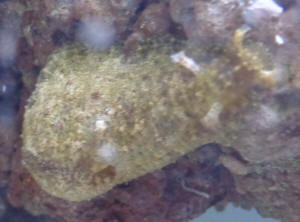 |
|
Re: Pondering Mollusks 4/23/13
Hi Bob,
I think the critter in question is a sea hare, perhaps something in the
genus Dolobrifera (like Dolabrifera dolabrifera - common, wide range in
warm seas, extremely variable in color). Unfortunately, all links
to the SeaSlug forum are out of commission (yikes - hope it's only
temporary!!), but here's a link w/a photo at the bottom of the page:
http://www.usca.edu/biogeo/zelmer/sansal/mollusca/gastropod/
Good photo here:
http://www.nudipixel.net/photo/00015298/
Hope that helps! Take care, Lynn
<Ah yes, now I see the "horns" top right... does look summat like this
from above. Thanks, BobF>
Re: Pondering Mollusks 4/23/13
Thanks, it could be that or something else entirely but those "Shrek
ear" appendages/rhinophores/tentacles (whatever they are) caught my eye.
Hope you're doing well and enjoying life! Take care, Lynn
<Thank you Lynn... have a painful malingering foot issue (gout plus),
but trying to do what I can. Cheers, B>
Re: Pondering Mollusks 4/23/13
Thanks, it could be that or something else entirely but those "Shrek
ear" appendages/rhinophores/tentacles (whatever they are) caught my eye.
Hope you're doing well and enjoying life! Take care, Lynn
<Thank you Lynn... have a painful malingering foot issue (gout plus),
but trying to do what I can. Cheers, B>
<<Ouch, that's got to hurt - hopefully you'll be back running and having
a good time hashing soon. Get this...of all the idiotic things - I
tore my rotator cuff swatting a fly(!) about two months ago.
<D'oh!... Yowch!>
Can you believe it? The funny part is that the fly got away! If I
were a more enlightened person, I would
consider this a lesson and allow flies to peacefully coexist in our
house.
Instead, I bought a fly-swatter because rolled up newspapers don't work
worth a darn!
Take care, Lynn>>
<And you! B>
|
|
Re: Very Confused... much more reading...
8/10/09
I've attached pictures of the Nudibranch which I believe is a
Caribbean sea hare but I am not sure?
<... not a Nudibranch, but an Aplysiid, a sea hare; Aplysia
dactylomela looks like to me>
One concern that I have is if he will ink if stressed, or
attacked?
<Might>
Although I don't think I have anything that will attack him.
He has been in there since 7/22 and seems to be doing good so
far, key words there! Thanks for the links about alkalinity and
calcium. I will check them out now.
I hope you or another crew member can positively identify my
Nudibranch so I know I am caring for him properly. Thank you very
much
Bobi
<Do search, read on WWM re... Bob Fenner>
|
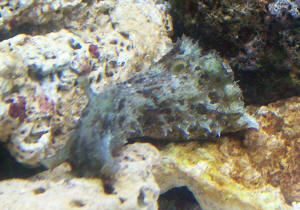 |
|
Re: Very Confused... Aplysiid ID
8/11/2009
Thank you Mr. Fenner! I will read everything I can find on him.
This little guy consumed all of our green hair algae in about 3
days and he is not really interested in the dried seaweed we
offer, so I am very afraid of him starving! I will read
everything possible but in the meantime, can you suggest a food
for him?
Thanks Bobi
<Please read where you were referred. B>
|
|
Nudibranch ID..Please? Blue-Ring Sea Hare --
5/15/09
Hello again WWM Crew,
<Hello again, Sandra - Lynn here again too!>
I found a Nudibranch in my quarantine tank on a small colony of
Palyzoas that I have not been able to identify.
<It does look like a Nudibranch, doesn't it? It fooled me
too, at first! It's instead a harmless species of Sea Hare
(family Aplysiidae) called Stylocheilus striatus, a common
circum-tropical slug that happens to eat blue green algae (yay!)
and only reaches about 65mm (roughly 2.5") in length. One of
its common names is the Blue-ring Sea Hare which is most
appropriate considering the color form that your individual
displays. For more information, please see the following link:
http://www.seaslugforum.net/showall.cfm?base=stylstri >
It's not like most of the Zoanthid eating Nudibranchs I have
ever found.
<Nope!>
I have looked at the Sea Slug Forum, WWM and several others with
pictures and with the thousands of Nudibranchs in existence, I
just can't find one that looks just like it.
<Believe me, I feel your pain. As much as I'd love to say
that I knew what that little guy was right away, I sure
didn't. I saw what I thought were gills on the back and went
completely off course! I must have looked at ten zillion photos
of Nudibranchs before I finally backtracked and looked at the
Aplysiids! I just know I'm going to be dreaming of sea slugs
chasing me tonight!>
I'm attaching 2 pictures that I narrowed down from about
50.
<Heee! You sound like me! Hey, it's always better to have
too many photos, than too few.>
It's not easy taking pictures of a moving quarter inch long
Nudibranch.
<No kidding, you did a great job!>
His body pattern looks like brown on white tree bark and it has
electric blue spots surrounded by a yellow-orange spot.
<It's definitely a beautiful little creature.>
If you know what this little guy is, do you know what his egg
case looks like
<This species leaves strands of eggs. See the photo at the
above link.>
..and their incubation period so I know how long to keep the
Palyzoas in quarantine.
<No worries with this little guy.>
Most Zoa eating Nudis have a "C" shaped white and clear
egg case and I haven't found any like that in this quarantine
tank.
<Good!>
Any help would be greatly appreciated. You guys are awesome.
<Why thank you!>
Thank you,
Sandra
<You're very welcome. Take care, LynnZ>
|
 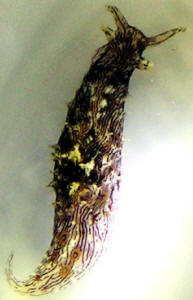 |
Re: Nudibranch ID..Please? Blue-Ring
Sea Hare -- 5/15/09
Thanks a bunch, Lynn, for both ID emails today, the sea hare and
the olive snail.
<You're most welcome!>
I was looking at pictures of the sea hare and thought it kind of
looked like one but like you said, it sure did look like gills on
the back. And I even looked at him under my microscope.
<I bet that was neat.>
If I hadn't thought those were gills on his back I probably
would have found him right away.
<Yep, I know the feeling.>
He doesn't seem as "hairy" as most of the sea hares I
have seen, either. On the Olive Snail, that was my second thought.
But I have never seen one so big before.
<I haven't either -- not alive, anyway.>
All of the olive snails I have ever seen have been less than an
inch. You had asked his possible origin and this tank was set up
with live rock from both Fiji and Indonesia and it's only been
up for about 6 months. I inspect and quarantine all of the corals
and other critters before they go near the tank
<Excellent>
and being that large it's probably safe to assume that he came
in on the live rock.
<Yep>
He must have been stuck in a hole.
<That would be my guess as well - or within a crevice.>
I am going to keep him in either the mantis tank or my quarantine
tank. It took me over a month to catch him this last time so I
don't want to take any chances of him deciding to find my
snails or other critters appetizing.
<I don't blame you. It's definitely the safe thing to
do, especially since he's so hard to find/catch.>
The mantis is a spearer that clicks from his back end and not the
front.
<Neat>
He came in live rock in my soft coral tank and it took 4 months to
finally catch him.
<I bet that was fun! They can be a real challenge to
catch.>
He's been in a separate tank for about 3 or 4 weeks now but I
haven't seen him eat anything in this tank. In the soft coral
tank he ate daily. Unfortunately, he started out eating gobies and
my clown fish before I discovered him.
<Uh-oh. That's not the way you want to find out you've
got a Mantis.>
But after that he would eat krill, silver sides, brine shrimp,
Mysis shrimp, crab meat, clams and prawn from a skewer or tweezers.
But since he has been in a tank of his own, I haven't seen him
eat anything. He won't take anything off the skewer anymore.
Maybe he's lonely now.
<Hmmm, I'm not sure what's up with that. As long as the
water parameters are fine and he's got sufficient
sand/rubble/rock to set up his lair, he should be okay. Are you
leaving any of the food behind for him? If so, perhaps he comes out
when you're not around or at night at nabs it then.>
Well he has the olive snail now to keep him company. He is
gorgeous, though. But definitely not photogenic. He's unlike
any mantis I have ever had. He loves the light. Shine a flashlight
and he follows it.
<Heee! I have a dog like that!>
Maybe he thinks he needs his own reality TV show. Why not?
Everybody else has one, why not Max, too?
<Indeed! Sometime when you have a chance, look up 'The
Continuing Adventures of Tim (Supermantis)' on the net.
It's a hilarious tale of a one-eyed Mantis shrimp.>
Thanks for your help, Lynn. I really appreciate it. Even in 20
years of keeping reefs you learn something new every day.
<Yep, and that's what makes it so much fun! Just think how
boring life would be if there was nothing left to learn!>
Sandra
<Take care, LynnZ> |
|
Not sure of this species and cannot locate it in any
library or online.
Creature ID: Sea Hare -- 4/15/09
Hello my name is Marshall Feather
<Hello Marshall, Lynn here today.>
..and I have been looking on-line and at the University of
Georgia Library and cannot find any species that matches or comes
close to this one I took a picture of. I first thought of a Red
Spanish Dancer but the two move totally different and the Dancer
does not carry a hump-like feature on its back. I first saw one
and then the next day I saw a school of these. When I got a
little closer to take pictures of its underside it shot out a
black ink.
<Heee! It's that human again -- swim for your lives! What
you saw were Sea Hares, herbivorous sea slugs in the family
Aplysiidae, reacting to a perceived threat. The species is most
likely Aplysia braziliana (color and pattern vary), but there are
other possibilities as well. Please see the link below for a
list. Simply enter Florida in the search box, then go to the
'Family' drop down menu below and select
'Aplysiidae':
http://www.seaslugforum.net/search_species.cfm
More links/information below:
Aplysia braziliana (also see associated links at the bottom of
the page):
http://www.seaslugforum.net/factsheet.cfm?base=aplybras
Sea Hare 'ink':
http://www.seaslugforum.net/factsheet.cfm?base=seahatac
>
Marshall
<Take care, LynnZ>
|
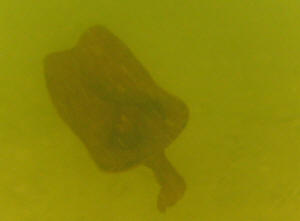 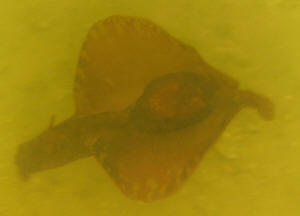 |
|
Surprise critter: Sea Slug? ID sources -
1/5/08 Hi all, <Hi Richard!> First, thanks for sharing
so much info on WWM - it's a big help! <Thank you,
it's our pleasure!> I've just set up my first marine
tank (after 20 years of FW tropical). <Such a wonderful,
rewarding hobby -- welcome to reefkeeping!> It's been
cycling for nearly 2 weeks. I kicked the cycling off with about
4kgs of LR, which I'm told came off the Victoria coast (Oz -
I'm in Melbourne). <Lucky you! I am determined to get to
Australia one of these days. The Great Barrier Reef has always
been at the top of my list of places to see/explore.> Ammonia
and nitrates are currently at 0ppm, although nitrites are at 2.5.
<Will subside/cycle out.> I've got a healthy supply of
copepods & amphipods flourishing already, also some snails.
<Yay!> Tonight I happened to pass the tank with the lights
off and spotted something strange on the back glass. I turned on
the lights and saw what appears to be a small sea-slug.
Unfortunately due to the amount of algae starting to grow
already, my camera wouldn't focus, so no photo I'm
afraid. <Darn.> It's a teardrop shape, about 15mm long,
5 mm wide and a brownish red in colour. It has two white feathery
antennae at the thin end of the teardrop and three small white
spots on it's back - almost a small smiley. <Oh I know, I
know! It's the rare and elusive Smiley Nudibranch, family
Smileyidae -- just kidding <g>. Sorry, I couldn't
resist!> It's quite flat, although the centre of the back
is raised about 3 mm. Any suggestions as to what it could be?
<Unfortunately, there are just too many possibilities and
without a photo...?> I'm planning on keeping seahorses in
the tank in another month or so <Go slowly here.> and
I'm trying to avoid nasty surprises. Algae eaters would be
fine though... <Understandable. If it were me, next time I saw
that little guy, I'd get him out of there.> Also, is there
any kind of marine creature search engine on the web into which
you can enter distinguishing features? <Not per se - that
covers all marine creatures. At least, not that I know of.>
Seems like something that would come in very handy for many
people :-) <Yes, indeed! In lieu of one specific search
engine, there are many sites on the web that can help (including
WWM!). I'll give you some of my favorites. The first will be
of particular use for you as it covers crustaceans of southern
Australia. You may find some of the amphipods/copepods/etc.
populating your tank here:
http://museumvictoria.com.au/crust/page1.html Here's another
site that's run by a friend in the Philippines:
http://home2.pacific.net.ph/%7Esweetyummy42/hitchhikers.html This
site is Dr. Shimek's dichotomous key -- very handy indeed!
http://www.ronshimek.com/Invertebrate%20Key%20to%20Major%20Taxa.htm
Great sites regarding Sea Slugs:
http://pick4.pick.uga.edu/mp/20q?guide=Rhabditophora&flags=not_no
http://www.wetwebmedia.com/seaslugsopisthobranchs.htm
http://www.seaslugforum.net/ I hope these help. I've got a
gazillion more on file, but these should get you started!>
Many thanks, Richard <You're very welcome! Take care
-Lynn>
Update: New marine tank with surprise critter - Nudibranch?
Sea Hare - 3/8/08 Hi Lynn, <Hey Richard! How's my
favorite Aussie doing?> Thanks very much for the info you sent
me. <You're very welcome.> The 'smiley slug'
disappeared for a little while, but a couple of weeks ago
surfaced again. <Neat> It's grown somewhat (35mm+)
since I last saw it, and I just wanted to let you know that
I'm now sure it's Dolabrifera dolabrifera, the algae
eating sea hare. <Yay, congratulations and good on you for
figuring out what it is! Thanks, also, for letting me know. Neat
little creatures like this tend to lurk in the back of my mind
until they're identified.> In fact, I seem to have about
five of them, and although the smiley looked quite different when
it was young (appeared to have a smooth back and white markings),
the similarities between the mature hares really make it obvious.
<Awesome> Now that I've watched them in action for a
few weeks, the following are pretty clear: - They don't eat
anything other than algae. - The colours come from the particular
algae that they're eating (slowly changes over a period of 5
- 6 days). Seems likely that the red pigment doesn't
penetrate all parts of the body - he's now pinkish brown with
green ears :-) <Heeeee! It's the Easter Sea Hare!> -
They're indifferent to what colour slug they mate with. -
They're not the smartest critter in the world and often
can't tell the difference between a rock and a seahorse (much
to the surprise of both parties when they go for a ride)
<Wheeeeee! Yep, it doesn't exactly sound like they're
sharpest tacks in the drawer!> Cheers, Richard <Thanks
again, Richard, for following up with this and for sharing your
observations! Take care and have a great weekend, -Lynn>
|
Sea Hare ID -- 09/25/07 Hi Bob,
<George> We took a shot of this animal and although it seemed
like an Aplysia dactylomela at first we have second thoughts now.
First because it was shot three days ago in the Mediterranean (and
not the Caribbean) and second because it doesn't show the
typical "wings" on its back. <Mmm, yes, but...> Do
you know what this species is ? Needless to say, you can use the
photo for your site (a higher definition photo can be sent to you
if you need it for publication). <Looks like Aplysia dactylomela
to me...> Best regards and many thanks,
George Reclos |
|

|
| Help ID this slug 5/10/07 Some people
on Reef Central think it's a slug but not sure what type or if
it is reef safe. Could it be a Sea Hare? I found it at night
underneath my Molokai LR. Does it eat algae? Thanks. <Is a
Common Sea Hare (or Kualakai in Hawaiian), Dolabrifera dolabrifera
(Rang, 1828), Family Aplysiidae... Do feed on algae, live under
rocks intertidally! Nice pix! Bob Fenner> |
|
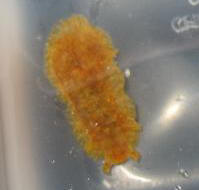 .jpg)
|
Carol at Ocean Rider, Hawaiian Sea Hares, pix of same Hey
Bob, <Carol!> So last time you called I got your message the day
after the party. What is with that? Did we misbehave at the last
gig???? <Heeee! Not enough!> Call my on me cell next time at 937
XXXX. <Will do> Hey I am working on a new web site with an invert
section. Do we have Aplysia juliana or californicus here in Hawaii?
<Juliana is, and a few others... See Hoover's "Sea
Creatures" pp. 149-153...> I thought it was Juliana but then
someone said they don't ink which ours definitely do! I need a nice
photo of one too if you have one. <I just looked... don't have a
decent pic of any of the Hawaiian species!> Aloha and Cya soon??
<Yes! Coming over next month for a few weeks. Will definitely
call... maybe we can all go out diving... to find, take pix of
Anaspideans! Hello to your husband and the boys. Bob Fenner>
Carol
|
|

